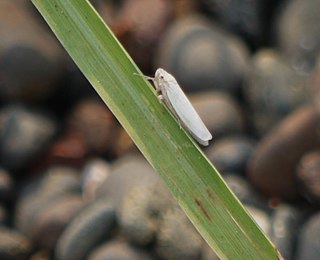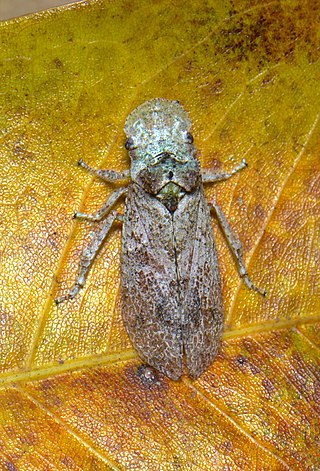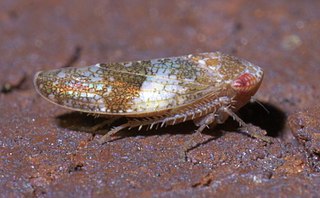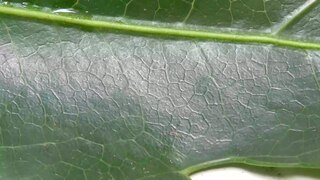
A leafhopper is the common name for any species from the family Cicadellidae. These minute insects, colloquially known as hoppers, are plant feeders that suck plant sap from grass, shrubs, or trees. Their hind legs are modified for jumping, and are covered with hairs that facilitate the spreading of a secretion over their bodies that acts as a water repellent and carrier of pheromones. They undergo a partial metamorphosis, and have various host associations, varying from very generalized to very specific. Some species have a cosmopolitan distribution, or occur throughout the temperate and tropical regions. Some are pests or vectors of plant viruses and phytoplasmas. The family is distributed all over the world, and constitutes the second-largest hemipteran family, with at least 20,000 described species.

The common brown leafhopper is one of the most common species of Australian leafhoppers with a very wide host range. It is an important vector of several viruses and phytoplasmas worldwide. In Australia, phytoplasmas vectored by O. orientalis cause a range of economically important diseases including legume little leaf, tomato big bud, lucerne witches broom, potato purple top wilt, Australian lucerne and the insect is a possible vector of Australian grapevine yellows. O. orientalis also transmits Tobacco yellow dwarf virus to beans, causing bean summer death disease and to tobacco, causing tobacco yellow dwarf disease.

Deltocephalinae is a subfamily of leafhoppers. Deltocephalinae is the largest subfamily in the family Cicadellidae and is divided into 40 tribes, comprising over 925 genera, and over 6,700 described species.

Opsiini is a tribe of leafhoppers in the subfamily Deltocephalinae. The tribe contains 36 genera and over 300 species divided into four subtribes: Achaeticina, Circuliferina, Eremophlepsiina, and Opsiina.
Mohammed Sultan Khan Ghauri is a biologist specialist of Hemiptera.

Eurymela is a genus of leafhoppers. There are seven known species, and they are found throughout mainland Australia. The two most common species are E. fenestrata and E. distincta. E. fenestrata is the type species. Species of the genus are commonly known as "Jassids". They feed on the sap of Eucalypts.

Eurymela distincta is a species of leafhopper native to the Australian continent. It has a wedge-shaped body that is 10–12 mm long or 12–14 mm long. The head is black with cream or white maxillary plates. The pronotum and scutellum are black. The tegmen is black with a blue or purple tinge, and one to three white fasciae. The costal margin is black. Legs are scarlet close to the body and black further away. Underparts are scarlet.

Cofana is a genus of leafhoppers belonging to the family Cicadellidae. Cofana species can be often found in grass habitats and in rice fields. Some species have been recorded on Dinochloa scandens (Poaceae). The genus Cofana is distinguished by their male genital morphology, with an aedeagus lacking paraphyses and basal processes. The hindwing lacks vein R2+3. Species in the genus are found in Africa, Asia, and Australia.

Ledrinae is a relatively small subfamily within the very large and diverse leafhopper family Cicadellidae. Originally placed in its own family, the "Ledridae", it is based on the type genus Ledra.

The Blissidae are a family in the Hemiptera, comprising nearly 50 genera and 400 species. The group has often been treated as a subfamily of the Lygaeidae but was resurrected as a full family by Thomas Henry (1997).

Hecalini is a tribe of leafhoppers in the family Cicadellidae. There are about 24 genera and over 180 described species divided into two subtribes in Hecalini.

Norvellina is a genus of leafhoppers in the family Cicadellidae. There are at least 30 described species in Norvellina.

Scaphoideini is a tribe of leafhoppers. There are 64 genera and over 600 described species in Scaphoideini.

Exitianus is a genus of leafhoppers in the family Cicadellidae. There are more than 50 described species in Exitianus.

Iassinae is a subfamily of leafhoppers in the family Cicadellidae.

Nephotettix is a genus of planthoppers in the subfamily Deltocephalinae and tribe Chiasmini. Species are mostly found in Asia, although two are from Africa.

Evacanthinae is a subfamily in the family Cicadellidae (leafhoppers).

Chandrashekaraswami Adiveyya Viraktamath is an Indian entomologist who specializes in the systematics of leaf-hoppers, Cicadellidae. He served as a professor of entomology at the University of Agricultural Sciences, Bangalore.
Paralimnini is a tribe of leafhoppers in the subfamily Deltocephalinae. Paralimnini contains 139 genera and over 900 species divided into two subtribes: Aglenina and Paralimnina. The tribe has a cosmopolitan distribution.
Rubria is a genus of leafhoppers in the family Cicadellidae, the species of which are found mostly in Australia. Swedish entomologist Carl Stål described the group as a subgenus of the genus Petalocephala, but later raised it to a genus in its own right in 1966 by J.W. Evans. The genus is a distinct lineage within the family and is placed in its own tribe Rubrini.
















